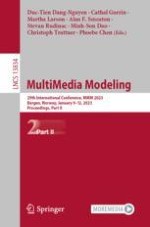2023 | Book
MultiMedia Modeling
29th International Conference, MMM 2023, Bergen, Norway, January 9–12, 2023, Proceedings, Part II
Editors: Duc-Tien Dang-Nguyen, Cathal Gurrin, Martha Larson, Alan F. Smeaton, Stevan Rudinac, Minh-Son Dao, Christoph Trattner, Phoebe Chen
Publisher: Springer Nature Switzerland
Book Series : Lecture Notes in Computer Science
